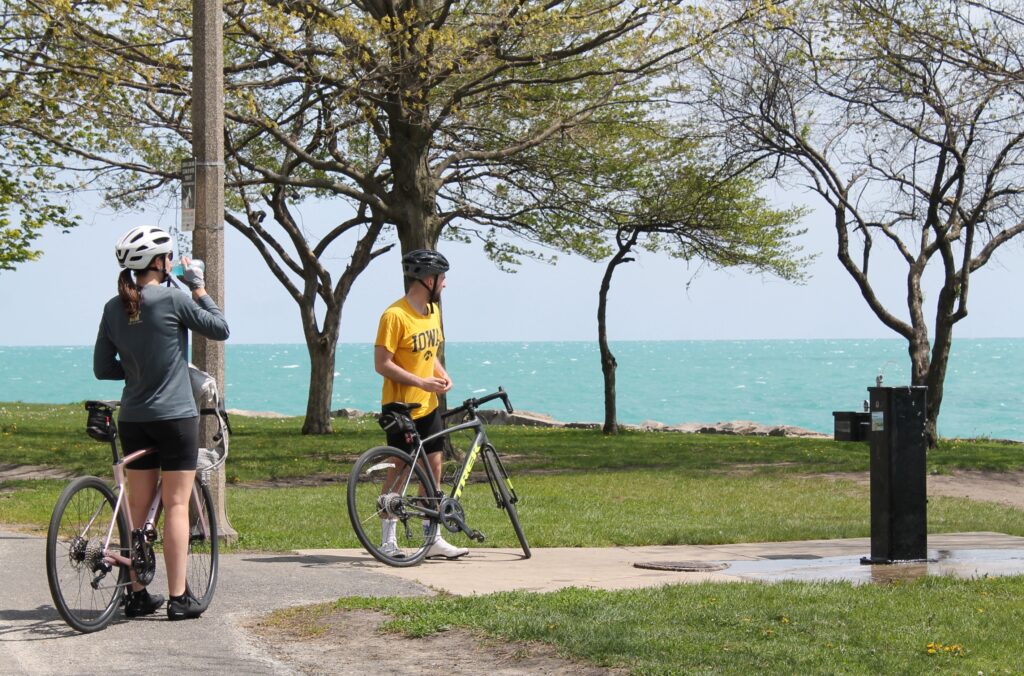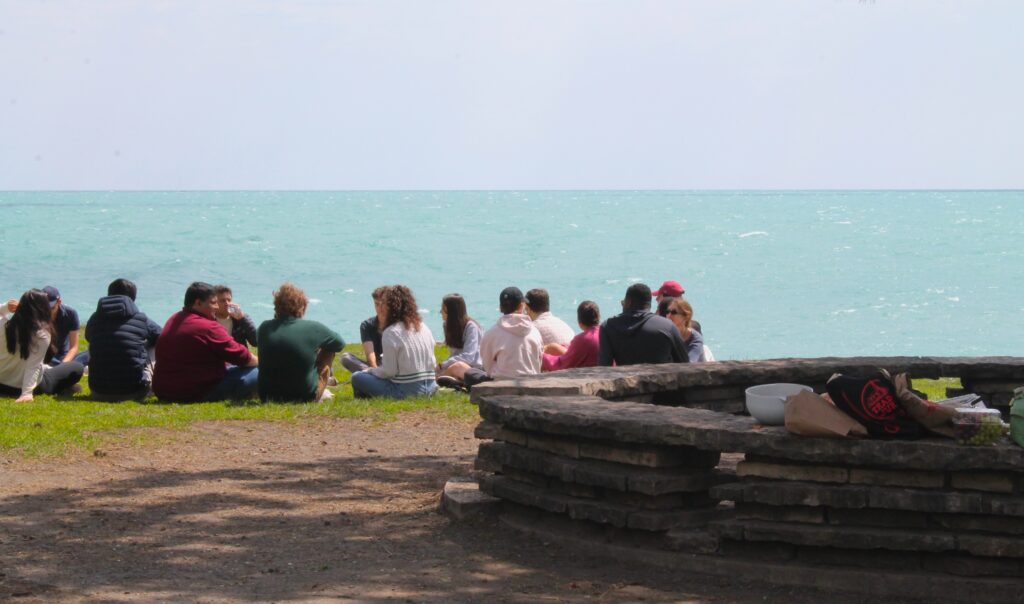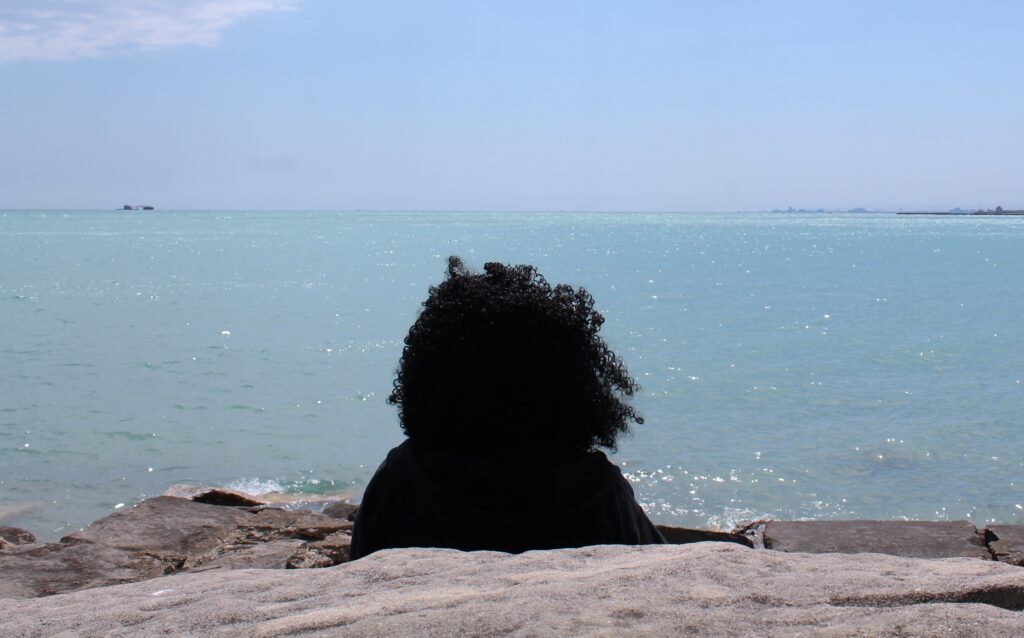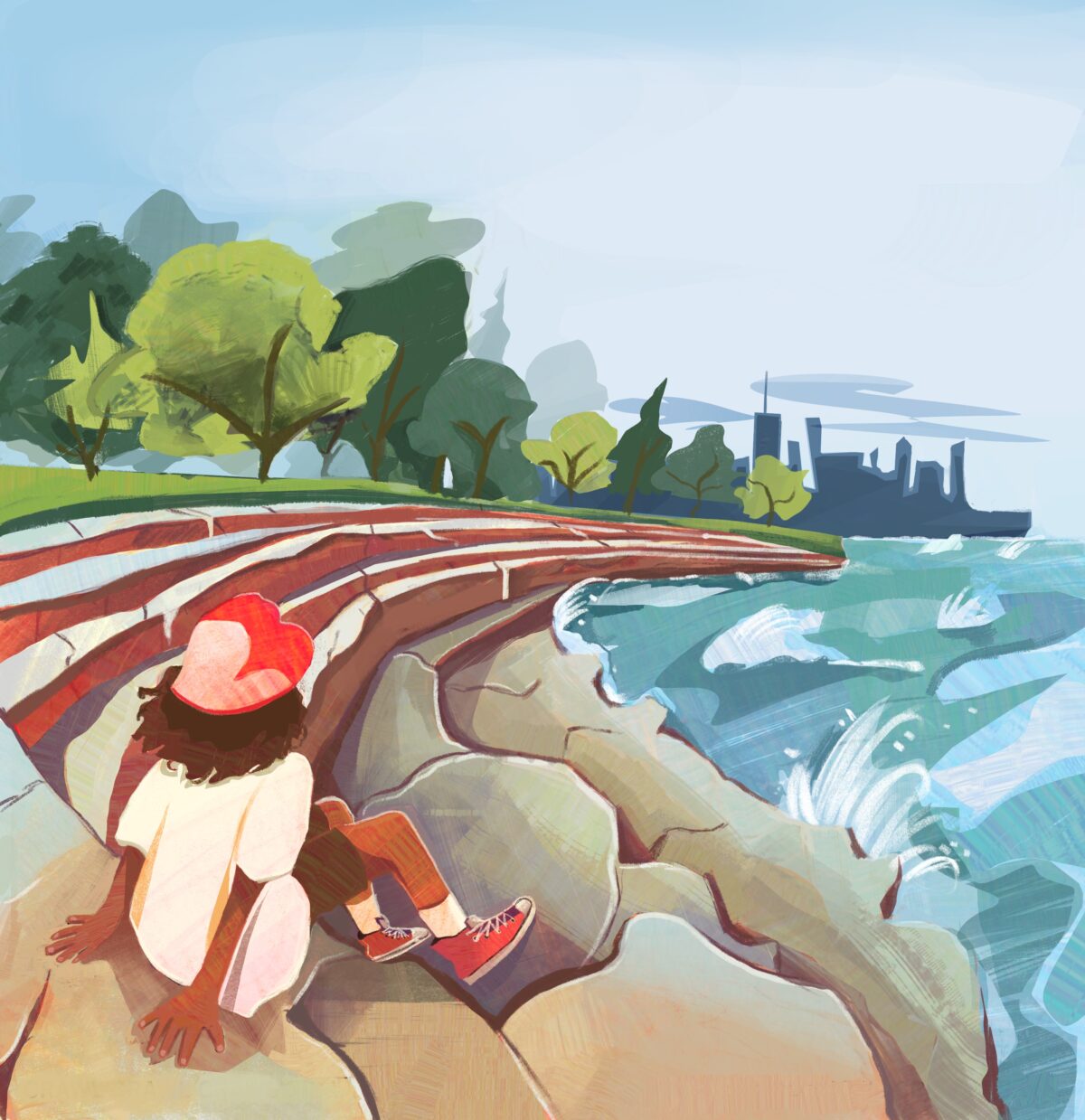On a sunny morning in May, Connie Lowery rested against Promontory Point’s limestone rocks and gazed out at the twinkling blue water of Lake Michigan.
“This is my place where I come to get all four elements,” said Lowery.
A Hyde Park resident, Lowery has been visiting Promontory Point regularly for decades and considers it essential for her well-being. The lapping waves, cool green grass, crisp spring breeze, and scattered bonfire pits envelop her in water, fire, air and earth. Promontory Point’s fifth element is the energy of human connection that radiates throughout the park.
Designated a Chicago landmark in 2023, Promontory Point has long been a beloved community space. Multiple gatherings happen simultaneously: a wedding in the fieldhouse, a family reunion by the bench tables, and a first date picnic can all happen within a few feet of each other. Meanwhile, dozens of bikers, runners, baby strollers and rambunctious dogs travel up and down the park trails.
The beloved limestone rocks that serve as stair-step revetment to Lake Michigan are a signature part of what makes the space special. They have also been the subject of intense debate and controversy over the past two decades, since the US Army Corps of Engineers (USACE) and the Chicago Department of Transportation (CDOT) first proposed that the limestone be replaced with concrete in order to buttress the shoreline against rising lake levels. Those proposals faced pushback from community members, who have organized to preserve the park’s limestone and mobilize park goers toward civic engagement, in part through the advocacy of the Promontory Point Conservancy.
In recent years, USACE and CDOT have said they are no longer considering plans to replace the limestone with concrete and want to “preserve as much of the limestone as possible.” But absent specific construction plans that commit to these values, community members are wary of what might happen. Whatever the future brings, South Siders’ fierce love for Promontory Point proves it’s more than a recreational space, but a sanctuary offering respite from the relentless pace and demands of modern city living.
The Healing Power of Lake Michigan
Emerging out of the pedestrian tunnel under DuSable Lake Shore Drive from 55th street to Promontory Point is like crossing a threshold, from the bustling city life of Hyde Park and darkness of the tunnel to the lush green trees and turquoise blue horizon of the park. By early May, Chicagoans—especially South Siders—start frequenting Promontory Point regularly. Friends meet up for coffee, college students plan social picnics, and deep water swimmers arrive before sunrise to plunge into the cool waters.
KJ Hickers and Nikita Obeegadoo are two such friends, sitting on a park bench and enjoying each other’s company on a sunny spring day. The pair became friends in the fall when Obeegadoo moved from her home country of Madagascar to Chicago. Their relationship as colleagues expanded to a friendship that includes regular visits to Promontory Point to enjoy the weather, the view of Lake Michigan, and a cup of coffee. Having grown up on an island, Nikita finds the lake’s vastness deeply moving.

“It just felt so magical,” said Obeegadoo. “There is something about being by the water and seeing the water meet the sky—seeing that horizon line and just feeling like it’s endless.”
She described the sounds of the waves and the feeling the space evokes in her as “priceless.”
Hickers, who grew up in California near the Pacific Ocean, initially assumed a lake could never encompass the power and beauty of the ocean. Lake Michigan proved her wrong. Soon she started referring to it affectionately as “the Michigan Sea.”
The “infinite” feeling of the Lake that Obeegadoo describes aligns with the language architect Alfred Caldwell used when describing his design vision for Promontory Point back in a 1986 interview as “a sense of the power of nature and the power of the sea.” As the third largest body of fresh water in the country, the waves change dramatically with the weather as does the color of the water and the breeze.
“I’ve been here seven years, and I can’t predict what color the water is going to be,” said Hickers. To her, experiencing the ever-changing nature of the Lake creates a “space of possibility” that feels “vital in a time when so many things feel constrained.”
Most importantly, the quiet embrace of nature makes room for a reflection and appreciation that’s easy to take for granted in the outside world.
Lowery’s introduction to Promontory Point was also rooted in friendship. She remembers coming to Promontory Point for the first time with a high school friend over thirty years ago, and being “captivated” by its beauty.
“It was our senior year of high school, and I remember going through the little tunnel,” said Lowery. She recalls how they sat on the limestone rocks and her friend shared his visions and dreams for the future.
“He said that this was actually the place that he comes to when he came to think,” said Lowery. The seed of contemplative reflection has stayed with Lowery years later. She often walks over to sit on the limestone rocks and reflect during “high intensity points” in her life.
“No matter where I am in the city, I come here,” said Lowery.
Debra Hammond, the Promontory Point Conservancy’s treasurer, has spent years advocating for the protection of Promontory Point’s limestone rocks and speaks of them tenderly.
“When you walk down the rocks and you sit, you feel cocooned a little bit, which is really special. They fit human bodies,” said Hammond.
This human connection with the ancient power of nature grounded Hammond when she moved from Los Angeles to Chicago in 1982 to attend the University of Chicago. She credits Promontory Point as the space that helped her get through graduate school, giving her access to a large body of water that reminded her of the beaches she grew up frequenting in California.
Jack Spicer, the conservancy’s co-founder and president, also remembers first visiting Promontory Point for the first time in 1965 for a friend’s prom. Hammond and Spicer remember it as the place they shared their first kiss, a little over a decade ago—what Hammond calls the beginning of a “late-life romance.”
Hammond and Spicer both know the importance of Promontory Point from a preservationist standpoint, but also understand it as the setting for some of the most profound moments we have in life: to grieve, rejoice, and love.
‘A space worth fighting for’
There is a long history of community organizing to protect Promontory Point’s natural beauty and accessibility.
In the 1950s, the U.S. Army leased land from the Park District for a radar site at Burnham Park with towers up to 150 feet tall, surrounded by a barbed wire fence. In the 1960s, locals began protesting, and the towers finally came down in 1971.
Around that same time, in the spring of 1967, the Human Be-In events that started in San Francisco as part of the 1960s counterculture made their way to Promontory Point. The South Side space was a rarity in Chicago, supporting the convergence of people from many racial and economic backgrounds. The peaceful gathering was an affront to the ongoing racial and class tensions that were present throughout the city.

In 2000, a new era of resistance was sparked when CDOT first presented plans to replace the historic limestone revetments at Promontory Point with concrete. Community members created the Community Task Force for Promontory Point and the “Save the Point” community initiative focused on protecting its historic limestone. Spicer would later co-found The Promontory Point Conservancy, to continue doing this work under the more sustainable structure of a non-profit.
The conservancy has conducted four engineering studies, primarily funded by the community, to show that the seawall can be repaired and rehabilitated. Their proposed design plans detail ways to keep the park’s natural beauty intact and keep the space consistently open to visitors.
“[They can keep] as much as 80 percent of the park open at any one time. They can just fix it in pieces. They don’t have to close the whole park,” said Hammond. “They could fix it in less than a year, if the weather permitted.”
In a statement to the Weekly, a spokesperson for CDOT stated that, “No design work has begun on the Promontory Point segment of the Shoreline Protection Project” and that “project partners are working with the Promontory Point Conservancy, the Advisory Council on Historic Preservation and the Illinois State Historic Preservation Officer to develop a Programmatic Agreement for the planning, design and construction of the Promontory Point segment, which will guide the design process to ensure compliance with the Secretary of the Interior Standards for Historic Preservation.”
The statement continued: “Because the design phase has not yet started, there is no confirmed construction schedule, start date, or cost estimate at this time. Any future construction remains several years away. These details will be developed during the design process and shared with the public as planning progresses.”
Earlier this year, the Promontory Point Conservancy hosted a series of ten community meetings to discuss the studies and get community input on what should happen to the Point. The community’s concerns were clear. “They want to be able to swim. They want to keep it peaceful, and they want to keep it safe,” said Hammond.
Hammond distributed a supplemental survey to people who utilize Promontory Point to better understand the impact the space was having on visitors. With over 500 responses to date, she found an overwhelming number of respondents identified the Point as a “safe place”—contradicting the often stereotypical narratives about the South Side.
Her research also shows that people visit Promontory Point year round, enjoying the frigid beauty of the winter as much as the comfort and warmth of the summer.

Through their conversations with community members, they’ve heard moving statements. A cyclist from Little Village shared that Promontory Point is “the only peaceful place in the whole city where she can decompress.” Another person shared that “the veil between the spiritual world and the physical world is thinner here.”
“People come here for nourishment and nourishing themselves and their families and their communities in ways that are specific to this space,” said Hickers.
This summer will be Obeegadoo’s first in Chicago. She hopes to keep taking regular runs along the lakefront path and is excited to have picnics at the park now that the weather’s warming up.
Lowery anticipates being invited out by her brother-in-law for barbeques and beach days, though she’s mostly looking forward to having some quiet time with the water.
“I need The Point,” said Lowery. “After eight months of winter—because we don’t have fall—we fall in love with this place all over again.”
The deep love people have for the space is evident in the rituals and traditions people have created with the space. Deep water swim groups have been meeting on the peninsula since the 1920s, even before the park was built. Others have left their unique mark in the limestone contributing to the over 450 carvings made by Point visitors over the decades.
“This is the type of space worth fighting for and doing what needs to be done to keep this space open for future generations,” said Hickers.
Red and blue stickers proclaiming “Save the Point” are posted on lamp polls and water fountains throughout the park, serving as a constant reminder that the green space can’t be taken for granted.
“People’s identities are woven [into the space] and vice versa,” said Hammond.
“This is about people making sacred space, and that’s a powerful thing.”
Jasmine is a writer, facilitator and community builder living in Hyde Park. You can learn more about her work at www.jasbarnes.com.

